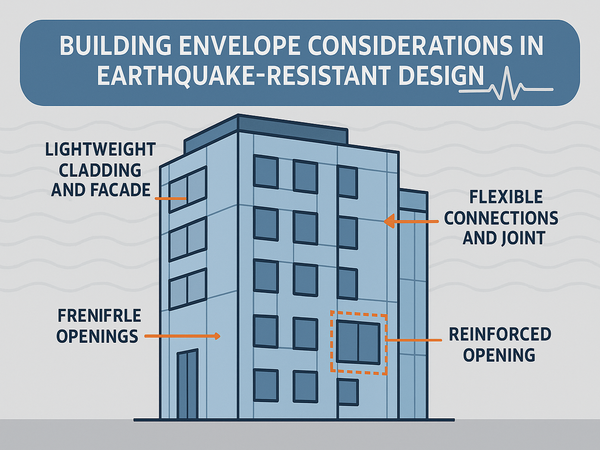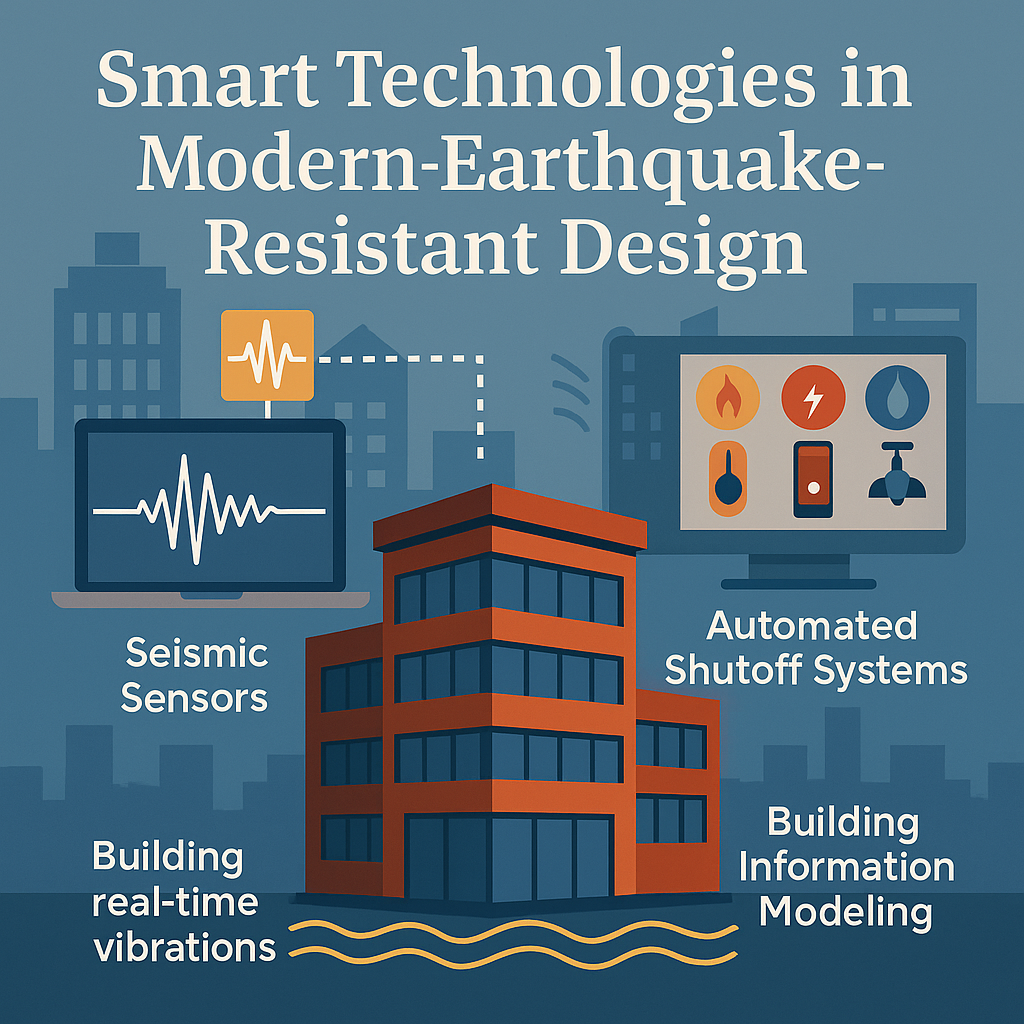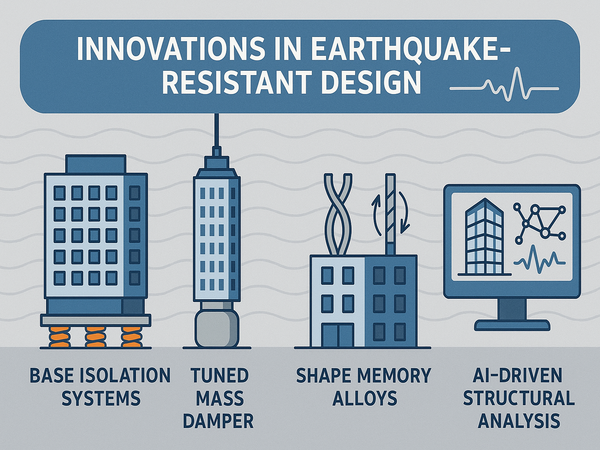Earthquakes are among the most devastating natural disasters, capable of causing massive structural damage and endangering human lives within seconds. As urbanization accelerates and populations grow in seismically active regions, the need for earthquake-resistant design has never been more critical. Modern construction practices now integrate advanced materials, engineering strategies, and smart technologies to ensure that buildings not only withstand seismic events but also protect occupants and minimize recovery costs. This blog explores the latest innovations in earthquake-resistant design, focusing on building envelopes and holistic structural solutions.
Understanding Earthquake-Resistant Design:-
Earthquake-resistant design refers to the engineering and architectural strategies used to ensure that buildings can absorb, dissipate, and recover from seismic forces. The goal is to prevent catastrophic collapse, minimize structural damage, and safeguard human life. This involves careful planning, material selection, and the integration of both passive and active design elements that work together to enhance resilience.
Key Principles of Earthquake-Resistant Design:-
1. Structural Flexibility and Ductility
A cornerstone of earthquake-resistant design is flexibility. Buildings must be able to bend and sway without breaking. Ductile materials such as reinforced concrete and structural steel are favored because they can deform under stress and return to their original shape, absorbing seismic energy rather than transferring it to brittle components.
2. Load Path Continuity
Seismic forces travel through a building’s structure in complex ways. A continuous load path ensures that these forces are safely transferred from the building envelope and superstructure down to the foundation and into the ground. Interruptions in this path can lead to weak points and potential failure.
3. Base Isolation Systems
One of the most innovative advancements in earthquake-resistant design is base isolation. This technique involves installing flexible bearings or pads between a building’s foundation and its superstructure. During an earthquake, these isolators absorb and dissipate ground motion, reducing the forces transmitted to the building above.
Building Envelope Considerations in Earthquake-Resistant Design:-
The building envelope the outer shell that separates the interior from the exterior plays a crucial role in seismic resilience. A well-designed envelope not only protects against weather and temperature extremes but also enhances a structure’s ability to withstand earthquakes.
1. Lightweight Cladding and Facades
Heavy exterior materials can become hazards during seismic events. Modern earthquake-resistant design favors lightweight, flexible cladding systems that are securely anchored yet able to move with the structure. Materials like fiber cement panels, aluminum composites, and engineered wood products are popular choices.
2. Flexible Connections and Joints
Rigid connections between envelope components can crack or fail under seismic stress. Innovative designs now incorporate flexible joints, expansion gaps, and sliding connections that allow controlled movement without compromising the building’s integrity or weather resistance.
3. Reinforced Openings
Windows and doors are vulnerable points in any building envelope. Earthquake-resistant design strengthens these areas with reinforced frames, laminated glass, and secure anchoring systems to prevent shattering or detachment during shaking.

Advanced Materials in Earthquake-Resistant Design
Material science has revolutionized earthquake-resistant design by introducing products that combine strength, flexibility, and sustainability:
- High-Performance Concrete: Enhanced with fibers or polymers to improve ductility and crack resistance.
- Shape Memory Alloys: Metals that return to their original shape after deformation, used in critical connectors and braces.
- Engineered Timber: Cross-laminated timber and glulam beams offer both resilience and sustainability for seismic zones.
- Seismic Dampers: Devices that absorb and dissipate energy, reducing the amplitude of building vibrations.
Smart Technologies and Monitoring
Modern earthquake-resistant design increasingly relies on smart technologies:
- Seismic Sensors: Installed throughout a building to monitor real-time vibrations and trigger safety systems.
- Building Information Modeling (BIM): Allows engineers to simulate seismic events and optimize designs before construction begins.
- Automated Shutoff Systems: For gas, electricity, and water, reducing secondary hazards during and after an earthquake.

Integrated Design Strategies
A holistic approach to earthquake-resistant design involves collaboration among architects, structural engineers, and building envelope specialists. Integrated strategies include:
- Passive Design: Using building orientation, symmetry, and mass distribution to naturally improve seismic performance.
- Active Design: Incorporating mechanical systems like base isolators and dampers for dynamic protection.
- Sustainable Design: Selecting materials and systems that not only enhance earthquake resistance but also reduce environmental impact.
Real-World Examples of Earthquake-Resistant Design
- The Bullitt Center (Seattle, USA): Features a high-performance envelope and flexible structural system, designed to exceed seismic codes.
- Mori Tower (Tokyo, Japan): Utilizes base isolation and advanced damping systems, with a robust envelope that maintains integrity during earthquakes.
- Christchurch Art Gallery (New Zealand): Rebuilt with base isolators and reinforced envelope systems after the 2011 earthquake.
Challenges and Future Trends
Despite significant advancements, challenges remain in earthquake-resistant design:
- Retrofitting Older Buildings: Many existing structures lack modern seismic protections and require complex upgrades.
- Cost Considerations: High-performance materials and systems can increase upfront costs, though they often reduce long-term risk and insurance premiums.
- Regulatory Variations: Building codes differ by region, requiring tailored solutions for each project.
Looking ahead, expect further integration of AI-driven design, new composite materials, and real-time monitoring systems that will make earthquake-resistant design even more effective and accessible.
FAQs:-
Q1: What is earthquake-resistant design?
A: Earthquake-resistant design involves engineering strategies and materials that enable buildings to withstand seismic forces, minimizing damage and protecting occupants.
Q2: How does base isolation work in earthquake-resistant design?
A: Base isolation uses flexible bearings between the foundation and building to absorb and dissipate seismic energy, reducing the impact on the structure.
Q3: What materials are best for earthquake-resistant design?
A: Reinforced concrete, structural steel, engineered timber, and shape memory alloys are commonly used for their strength and flexibility.
Q4: Can older buildings be retrofitted for earthquake resistance?
A: Yes, retrofitting can strengthen existing structures with additional bracing, dampers, and reinforced envelope components.
Q5: How does the building envelope contribute to earthquake-resistant design?
A: A well-designed envelope uses lightweight, flexible materials and connections to move with the building, preventing hazardous failures during seismic events.
Conclusion:-
Innovations in earthquake-resistant design are transforming how we build for safety, resilience, and sustainability. By integrating advanced materials, smart technologies, and collaborative strategies, today’s structures are better equipped than ever to withstand seismic events. Whether you’re planning new construction or retrofitting an existing building, prioritizing earthquake-resistant design is essential for protecting lives and investments in a changing world.
Read More On:-
For more information about engineering, architecture, and the building & construction sector, go through the posts related to the same topic on the Specuwin Blog Page.
Find out more accurately what we are going to take off in the course of applying leading new technologies and urban design at Specuwin.
